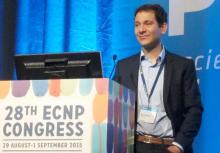AMSTERDAM – Electroconvulsive therapy’s efficacy in rapid relief from depression is well-established, particularly in the elderly, but the best ways to improve the treatment’s overall effectiveness over time remain a puzzle.
“There are still some questions,” said Dr. Willem A. Nolen, an emeritus professor of psychiatry at the University of Groningen (the Netherlands) and chair of a panel of ECT experts at the annual congress of the European College of Neuropsychopharmacology.
“There is a high relapse rate [with ECT]. So, how should we continue treatment? Do we use medication, continuation ECT, or psychological therapies?”
A meta-analysis published in 2013 showed that 27% of people with depression who were given ECT relapsed after 3 months. Just over half did so after 1 year, mostly in the first 6 months (37.7%). After 2 years, 50.2% of those treated with ECT had relapsed. The study also found that in randomized, controlled trials, antidepressants given after ECT cut the risk of relapse in half in the first 6 months, compared with placebo. The most effective antidepressants, according to the study, were tricyclics, but the researchers could not find enough data on other maintenance therapies, including other pharmacotherapies, to offer a definitive conclusion on what therapy best extends ECT’s effectiveness (Neuropsychopharmacology. 2013 Nov;38[12]:2467-74. doi: 10.1038/npp.2013.149). According to Dr. Malek Bajbouj, a presenter at the meeting, and professor of psychiatry and affective neurosciences at Freie Universität Berlin, perhaps a new logic is required when it comes to determining the best combination of ECT and add-on therapies.
This ethos forms the underpinning of an approach Dr. Bajbouj says he and his colleagues in Berlin are using to integrate treatment modalities, seeking ways to successfully overlap psychotherapeutic interventions, brain stimulation techniques, and pharmacological interventions.
But the approach is not without obstacles.
“If you give two interventions, take for example, ECT and medication, you can do it simultaneously or sequentially, or in an interactive manner. The outcome could be that we all think one and one is two, but this is not always true or what we’d expect or wish,” Dr. Bajbouj told the audience.
“It might be that there is a positive synergy, but it might also be that there are negative or neutral effects where one and one is still one.”
Take the recent findings from a study that left him slightly bewildered.
In a prospective randomized, controlled study of 90 inpatients, mostly in their 60s and all with major depressive disorder who were given either medication, medication plus maintenance ECT, or medication and cognitive-behavioral therapy (CBT) after their initial acute intervention with right unilateral ultrabrief ECT, Dr. Bajbouj and his colleagues found that after 1 year, CBT plus medication significantly outperformed the other continuation therapies (Biol Psychiatry. 2014 Aug 1;76[3]:194-202. doi: 10.1016/j.biopsych.2013.11.030).“The findings were against my personal expectations,” Dr. Bajbouj said. Those expectations cost him: In a bet with a coinvestigator who predicted that the talk therapy arm would outperform the others, “I ended up having to buy her a bottle of champagne.”
A third of the initial study group did not respond to the initial acute ECT. But of the 60 who did and who were randomly assigned their add-on therapy, and followed at 6 months and 1 year, 77% of those given CBT plus medication remained in remission at 6 months, and an impressive 65% did so at 1 year. Meanwhile, the medication plus ECT group had a 40% remission rate at 6 months and a 28% remission rate at 1 year. The medication-only arm had a remission rate of 44% at 6 months and 33% at 1 year.
Dr. Bajbouj suggested some factors that might have turned the results against his own calculations.
For example, in the medication arm, patients were not given standardized treatments of nortriptyline and lithium, as established as effective by Harold A. Sackeim, Ph.D., and his colleagues (JAMA. 2001 Mar 14;285[10]:1299-307), but were treated according to current guidelines to both accelerate recruitment rates as well as to avoid any adverse cognitive effects from the interaction of nortriptyline and lithium with ECT.
“We might discuss whether this reduced the likelihood that the people maintained their response rates,” Dr. Bajbouj said. Nearly three-quarters of those in the medication arm were taking two or more antidepressants, more than half were taking an antipsychotic, and a third were taking a mood stabilizer.
An additional factor also could have been the underlying refractory nature of the depression across the cohorts, since after the acute ECT treatment phase, patients in the CBT arm had lower remission rates, compared with the other arms (47% vs. 55% in the ECT plus medication arm, and 64% in the medication-only arm) and had higher Hamilton Rating Scale for Depression scores (24-question version) than the other two groups (8.4 points vs. 5.6 in the ECT plus medication arm and 6.3 in the medication-only arm).


